The productivity of a chicken depends on its nutrition. The more balanced the feed for her, the better effects you will get - large eggs with great regularity, rapid growth in meat poultry, better development of each chicken if you are feeding young. Therefore, it is extremely important to feed a balanced diet. Experienced poultry farmers use compound feed for these purposes.
Feed can be different. Some poultry farmers buy ready-made, granular formulations. Other people make their own mixtures. In general, there is nothing difficult to prepare, but it is important to know the ingredients. For different types of poultry, different types of feed are used. Let's talk in more detail about which feed is best for laying hens, what compositions are chosen for feeding meat poultry, and young animals.
What to feed laying hens?
Most often, poultry is kept for the purpose of obtaining eggs. However, in order for the egg to be of good quality, it is necessary to choose the right diet. Compound feed for poultry, which is contained for such a product as an egg, has a number of features. It must be balanced and contain the necessary norm of nutrients for the body of laying hens.In particular, the feed must be sufficiently saturated with proteins, ash and calcium. These substances make it possible to compensate for the losses in the body of the laying hen that occur during egg production. For example, calcium is important for eggshell strength.
Speaking about which feed is best for chickens, it is worth highlighting three types of diet. Including:
- Protein. Contain products with animal fats, herbs, yeast, legumes.
- Carbohydrates. Include flour and crumbly cereal products such as oats, wheat, millet.
- Vitamin. The composition of such feeds includes herbs, tops of plants, vegetables, coniferous flour.
It is also important to know about the important features of bird digestion. The chicken stomach is not able to fully digest food due to insufficient muscle activity. Therefore, the bird often pecks at various small stones, glass with turned edges, etc. This “little thing” grinds food in the stomach, thus improving absorption. Therefore, it is recommended to include shell or chalk in the compound feed.
As for feeding norms, it is necessary to take into account the age of the bird. The standard dietary intake for poultry is 150 grams per day. It is better to feed young birds more often and give more feed, as their productivity is more intense.
Compound feed for broilers
Another common question is which feed for broilers is better to choose. It is important to understand that its composition is different from the compound feed for laying hens, because there are completely different tasks. The faster the broilers gain weight, the less feed will be spent on their maintenance. Here, food is focused specifically on weight gain, since the only product from such a bird is meat.When choosing feed for broilers, it is important to understand that their fattening is divided into two stages. At the initial stage, it is necessary to ensure the growth of the bird. Therefore, the optimal composition will be as follows:
- Corn;
- Cake / meal;
- Wheat;
- Bone and herbal meal;
- Yeast;
- Animal fats.
Increase the proportion of bone meal and animal fats;
Replace corn in the composition with corn flour, and whole wheat with crushed wheat (increase the share of crushed wheat in comparison with the starting diet);
Slightly reduce the proportion of cornmeal (compared to starter corn) and bagasse
Broiler chickens can be given as little as 25 grams. feed per day. Before slaughter, an adult bird should be given at least 150 gr.
Compound feed for chickens
If you are raising replacement chicks, it is important to know which chicken feed to use. It is important to consider the age of the bird here. The diet changes as the chicks mature. For example, for young animals under the age of 10 days, the following composition is recommended:- ground wheat;
- ground barley;
- meal;
- Grated boiled carrots;
- Meat and bone meal;
- Yogurt.
For chickens over 21 days old, you can add cake, wheat turd and fish oil to the feed. Also at this age it is already worth adding chalk or shell rock to the feed for more efficient digestion.
 Found a mistake on the site? Tell us:
Found a mistake on the site? Tell us:

 Telegram
Telegram
